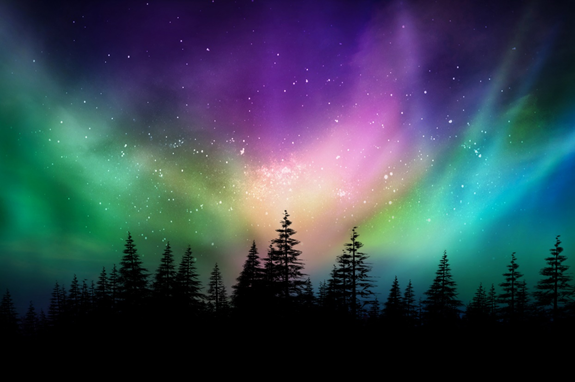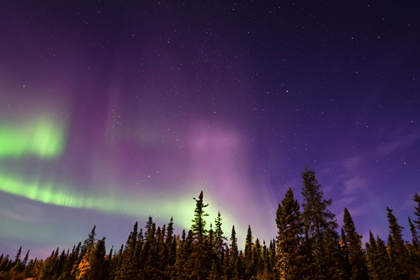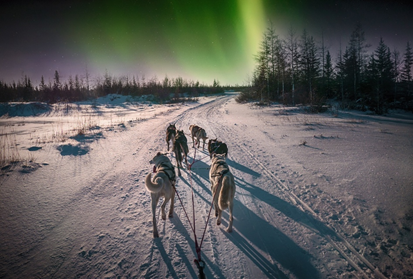9.3: Reading- The Northern Lights
- Page ID
- 104462
Before You Read
Working with a partner or by yourself, answer the following questions.
1. Have you seen the Northern Lights?
___________________________________________________________________
2. What do you know about the Northern Lights?
___________________________________________________________________
___________________________________________________________________
The Reading
Read the five short texts below. As you read, think about the purpose of each one, who the text might have been intended for, and where each one might have appeared.

Text 1
The Northern Lights, or Aurora Borealis, have fascinated observers for centuries. A natural phenomenon formed by solar activity, the Aurora appears as an incredible display of bright lights in the night sky; green, yellow, purple, and red swirls of light seem to dance across the vast open sky. This wondrous sight has inspired artists, poets, and composers throughout the centuries, and now it’s easier than ever to see it for yourself.
But don’t expect to see the Aurora from downtown Vancouver. For the best chance of seeing this incredible sight, you will need to venture to northern Canada. The most likely places in Canada to see the Northern Lights are the Northwest Territories and the Yukon. But you don’t need to head into the wilderness by yourself: you can often get good views of the Aurora from the more populated centres of Whitehorse and Yellowknife, and if you want to go further afield, there are plenty of companies offering night trips to more remote locations.
There are many ways to see the lights. Those with money to burn can book an expensive package tour, but these tend to cater to visitors who need the security of a group tour. You can certainly do it alone, on a budget, and relatively easily. Air Canada has non-stop flights from Vancouver to Whitehorse and Yellowknife; watch for sales. See page 47 for travel details. You’ll want to stay for at least three or four nights to maximize your chances of getting a good view. Once you’re in the north, there is no shortage of inexpensive family-owned motels offering a clean, warm bed for a few nights.
A word of caution: the Aurora is most visible in the winter months, and winters in the north are cold! You’re also likely to be outside at night; the best time to see the Aurora is around midnight. This means you will need to dress appropriately. You’ll need a parka that can withstand temperatures of −40◦, waterproof, fur-lined boots, a hat, thick gloves, and a scarf.

Text 2
The Northern and Southern Lights, also called the Aurora Borealis and Auroral Australis, are a natural light display in the sky particularly in the high latitude (Arctic and Antarctic) regions known to be close to the magnetic poles of the Earth. Named after the Roman goddess of dawn, Aurora, and the north wind, Boreas, the ancient Greek explorers Pytheas, Hiorter and Celsius in 1741 all described evidence of magnetic control.
Most aurorae occur in an auroral zone which is typically 3° to 6° in latitudinal extent and at all local times or longitudes. It was established by Elias Loomis (1860), Hermann Fritz (1881) and S. Tromholt (1882) that the aurora appeared in the “auroral zone,” a ring-shaped region with a radius of 2500 km around the Earth’s magnetic pole. During a geomagnetic storm, the auroral zone expands to lower latitudes as happened in 1859.
Kristian Birkeland (1900−1916) in his terrella experiments passed electric current through rarefied atmospheric nitrogen and oxygen around a magnetized sphere to cause coloured rings near the magnetic poles of the sphere just like the auroras in the sky. Neither he nor his associate Carl Stormer (who calculated such paths) could figure out why the actual auroras did not reach the poles themselves. Gill’s electronic theory of magnetism (1964) and this article help explain why these coloured rings do not reach all the way to the magnetic poles.
By Avtar Singh GillUsed under a Creative Commons Attribution License
Text 3
FAQ
How many people will there be on the tour?
We limit the size of groups to 24. Each group is accompanied by two award-winning tour guides, both of whom have expertise in wilderness exploration and first aid. Many of our guests are fluent in languages other than English.
What is the accommodation and food like?
Our accommodation is of the highest quality. You will stay in luxurious cabins with wood-burning fireplaces and classic rustic décor. Our cordon bleu chefs will prepare delicious and nutritious meals, with such delicacies as foie gras and lamb en croute. With advance notice, we can cater for all dietary restrictions. Our restaurant is fully licensed with a tempting selection of fine wines and liqueurs.
What if we don’t see the Northern Lights? Can we get a refund?
The Northern Lights are a natural phenomenon, and we can make no guarantees of the length or quality of your viewing experience. While most tours do see the Lights, there is a possibility that adverse weather conditions will make viewing impossible. In the unlikely event that you are disappointed by your viewing experience, you will be entitled to a 50% discount on future tours with us.
What other tours do you offer?
Combine your Northern Lights Experience with one of our other unique adventures. Try your hand at dog sledding, snowshoeing, or ice fishing. See our Northern Adventures page for more once-in-a-lifetime opportunities.
Text 4
Infinite Sky

I’ve seen things most people will never see
I’ve seen wild elephants fight to the death
I shared food with an Amazon tribe that never leaves the jungle
Walked through temples so old and hidden the tourists can’t find them
But when I came up here and looked up into a sky that never ends
I saw things I couldn’t believe, colours I’d never imagined
Green and purple and chartreuse and a million others I can’t name
Swirling together and apart, chasing each other through bursts of lightning
Old and new, being born and dying, beginning and ending
Text 5
WHITEHORSE. The number of tourists in Canada’s far north continues to rise, according to Statistics Canada. The number of visitors to the Yukon has increased by 25% in the last 10 years, and growth is projected to continue. Encouraged by a weak Canadian dollar, low gasoline prices, and Canada’s reputation for safety, tourists spent $303 million in the Yukon in 2016, an increase of 6.7% over 2015.
Attractions for tourists include the Northern Lights, the local Indigenous culture, and the spectacular northern scenery. “We used to get a lot of hunters and wildlife photographers,” says motel owner Brad Wilson. “Now we’re getting more tour groups from outside Canada, from places like China and South America. I guess they’ve seen Niagara Falls. Now they want to see something different.”
For adventure tour operator Marcia Giller, the increase also means more business. “We’ve expanded our Northern Lights tour business,” she explains. “We used to run one tour per week through the winter. Now we can fill four times that many. We’ve also added dog sledding tours and wilderness camping.”
The increase in tourism is not welcomed by all residents. Whitehorse resident Alice Bone owns a knitwear business. “There is more light pollution than before,” she complains. “This is a pristine environment. I worry about the long-term effect of all these visitors.”
Questions
A. Check Your Understanding
Answer the following questions in your own words.
1. What causes the Northern Lights?
___________________________________________________________________
___________________________________________________________________
2. Where does the name Aurora Borealis come from?
___________________________________________________________________
___________________________________________________________________
3. How can you travel from Vancouver to Whitehorse or Yellowknife?
___________________________________________________________________
___________________________________________________________________
4. When is the best time of year to see the Northern Lights?
___________________________________________________________________
___________________________________________________________________
5. What should tourists take with them on a trip to see the Northern Lights?
___________________________________________________________________
___________________________________________________________________
6. What are some (a) positive, and (b) negative effects of increased tourism in the north?
___________________________________________________________________
___________________________________________________________________
B. Think about It
Think about the purpose of each text, who the text might have been intended for, and where each one might have appeared.
Text 1
Purpose ______________________________________________________________
Audience ______________________________________________________________
Place ______________________________________________________________
Text 2
Purpose ______________________________________________________________
Audience ______________________________________________________________
Place ______________________________________________________________
Text 3
Purpose ______________________________________________________________
Audience ______________________________________________________________
Place ______________________________________________________________
Text 4
Purpose ______________________________________________________________
Audience ______________________________________________________________
Place ______________________________________________________________
Text 5
Purpose ______________________________________________________________
Audience ______________________________________________________________
Place ______________________________________________________________
What aspects of each text led you to these choices?

